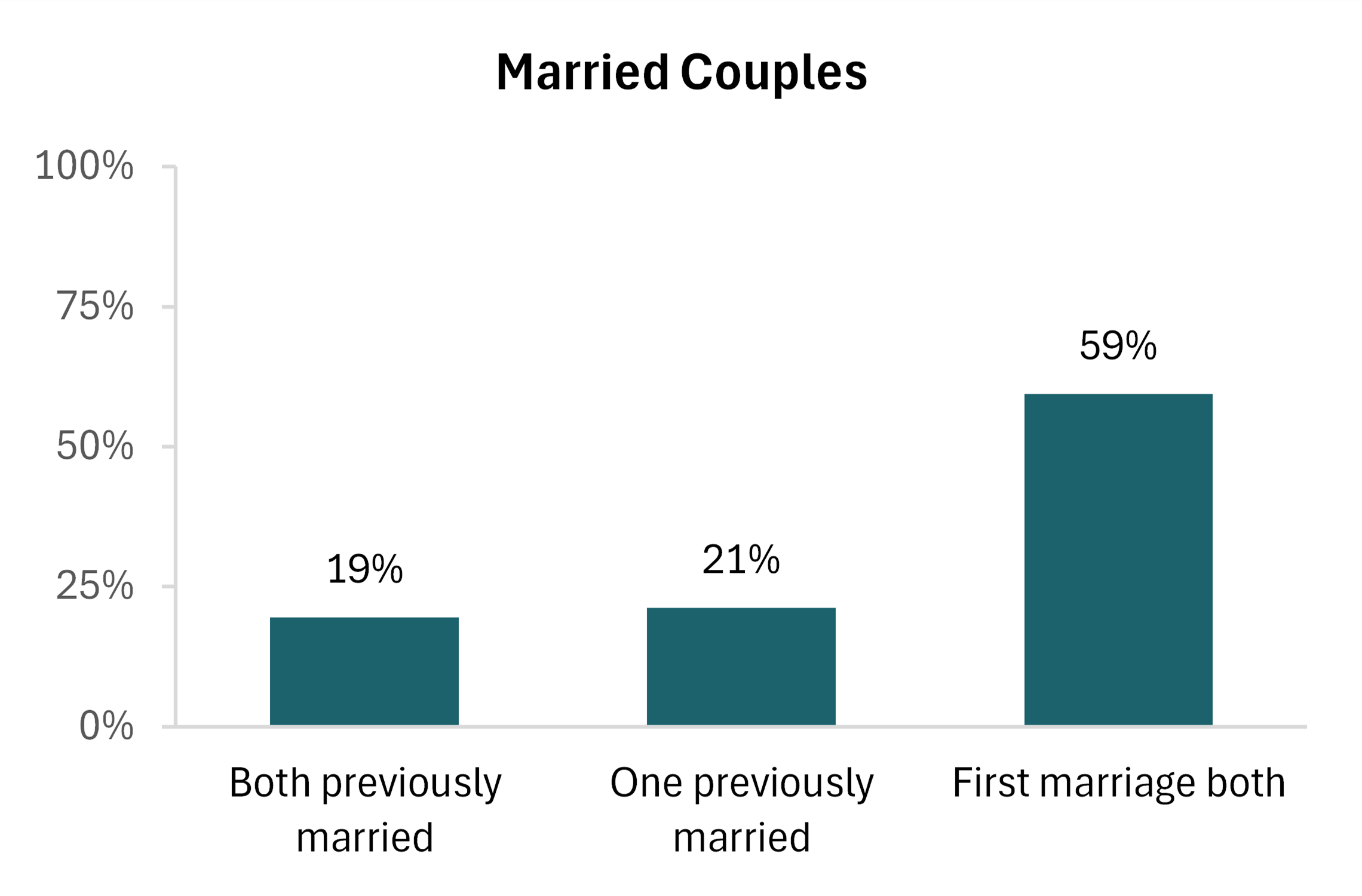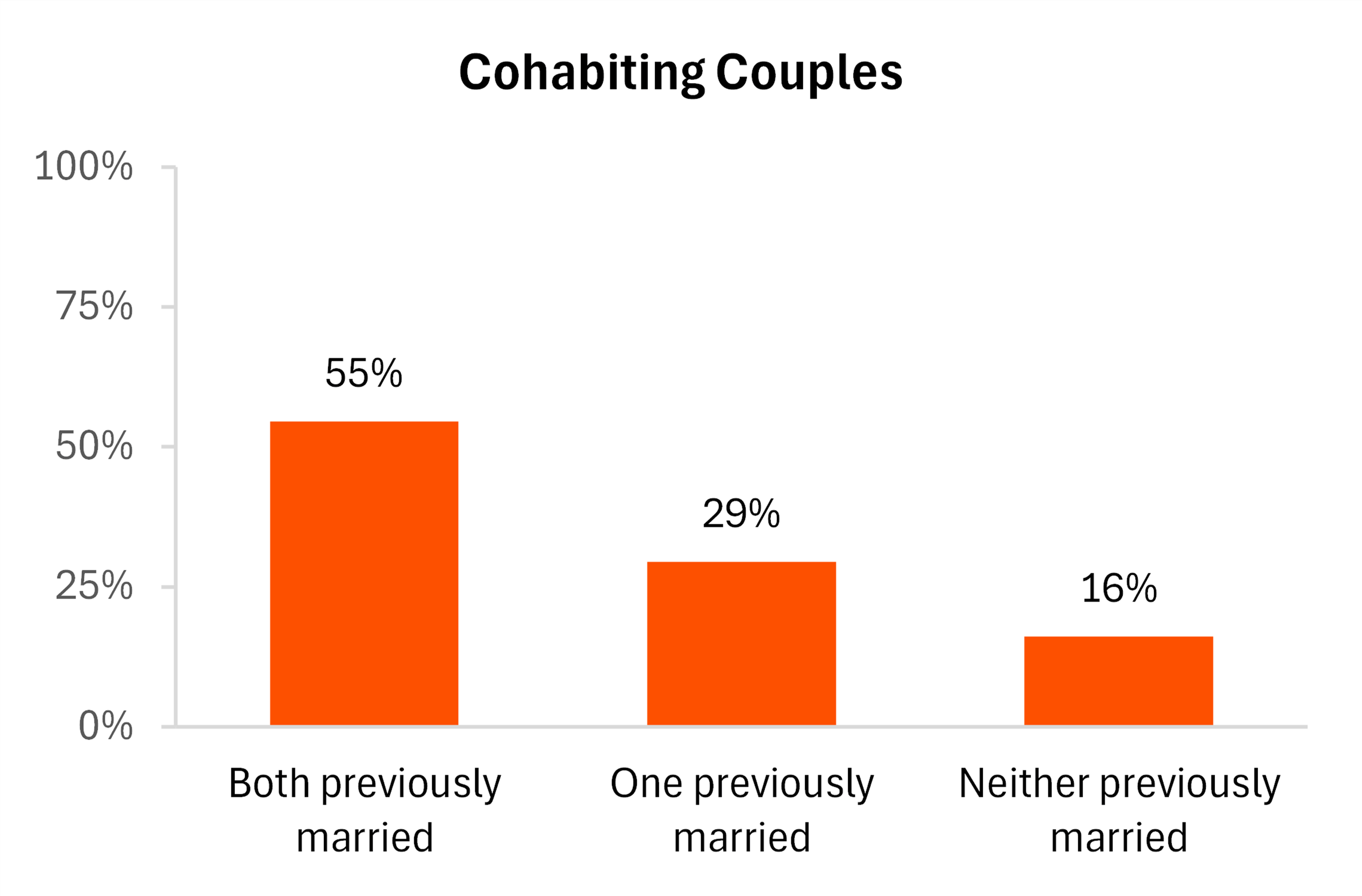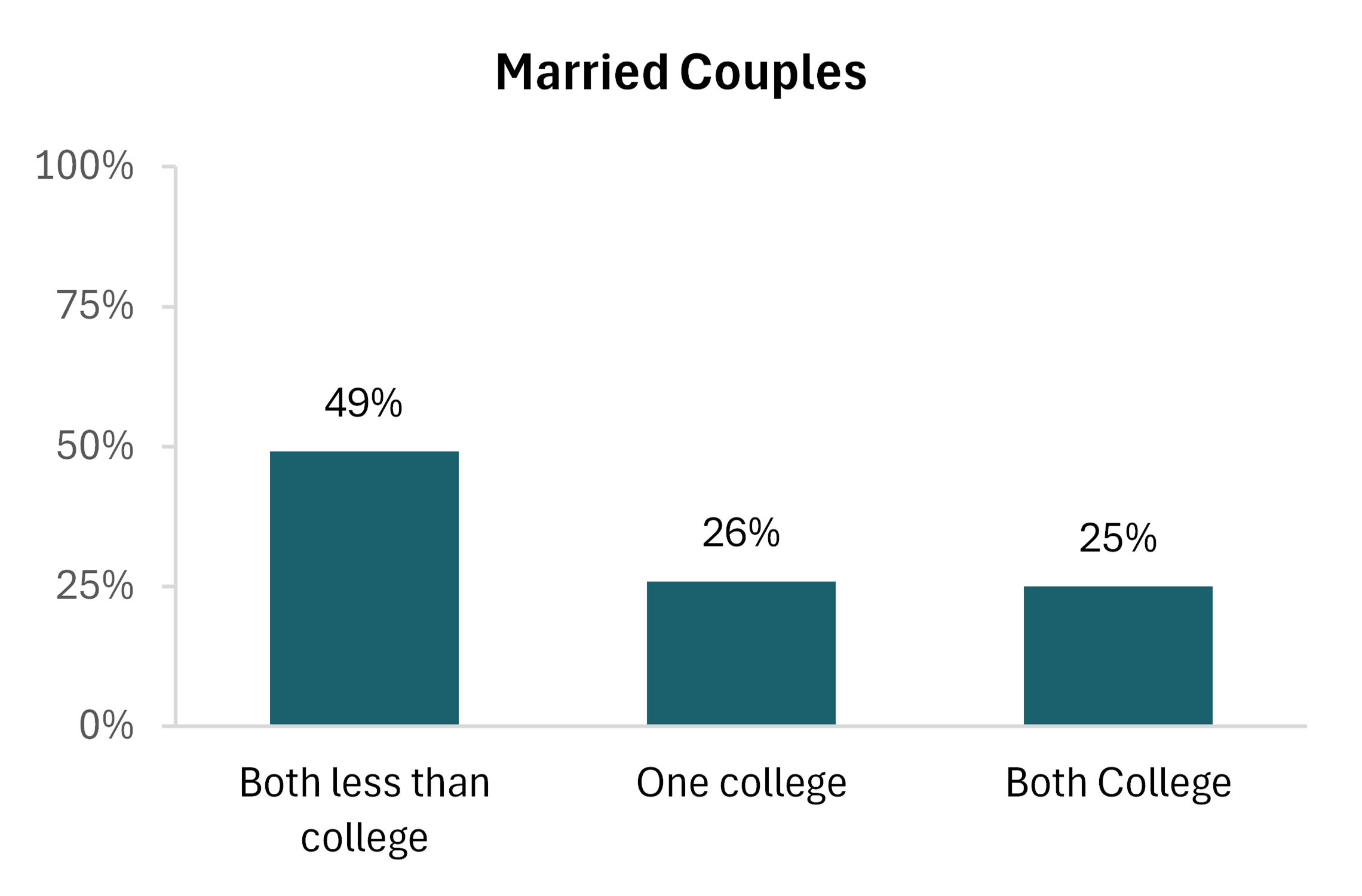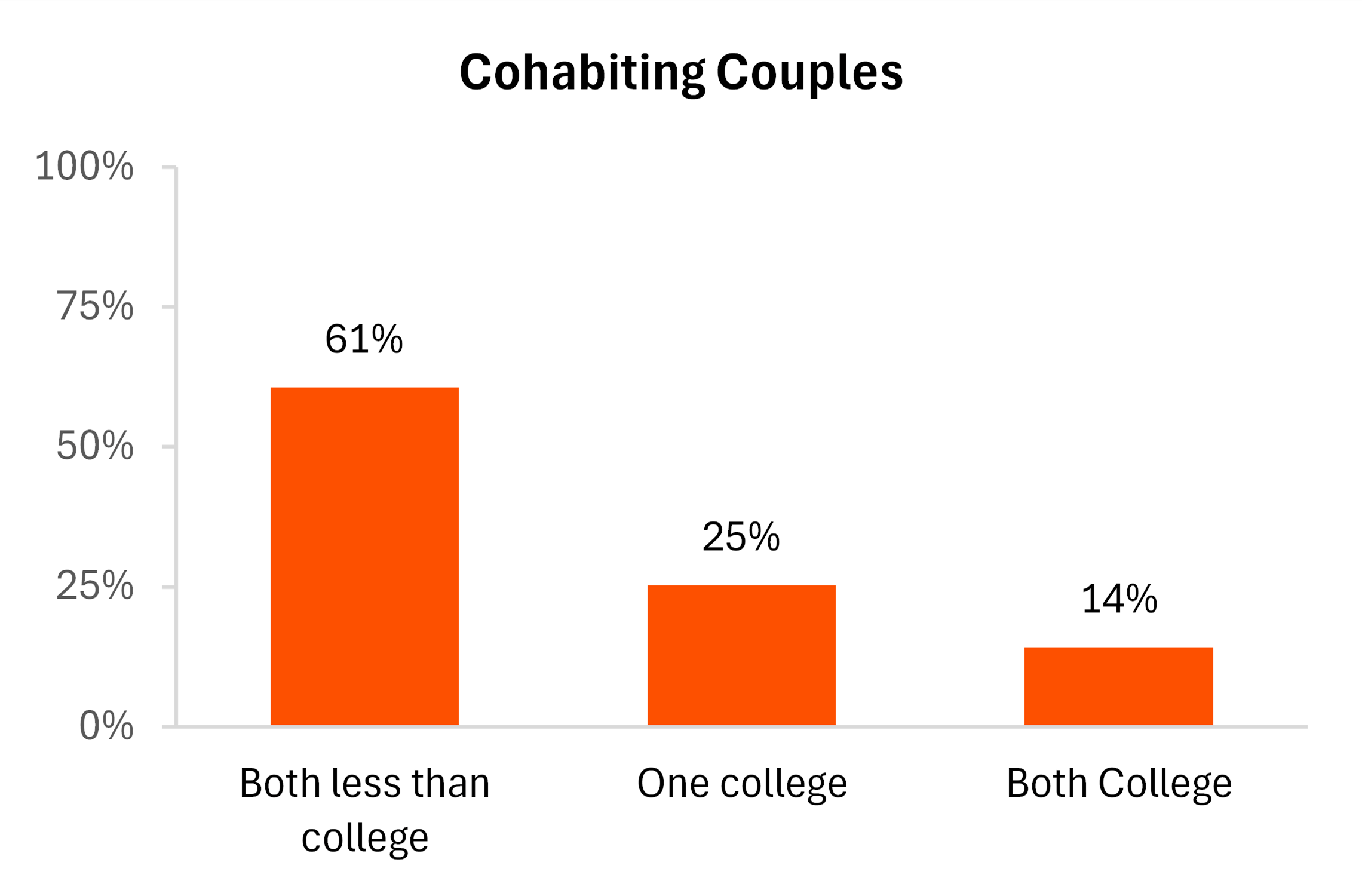Older Adult Cohabiting and Married Couples
Family Profile No. 8, 2025
Author: Christopher A. Julian
As gray divorce has increased over the past few decades (Brown, Lin, & Julian, 2024), many older adults have chosen cohabitation over remarriage when repartnering (Brown et al., 2019). In 2000, fewer than 1 million older men and women cohabited (Brown, Lee, & Bulanda, 2006). By 2017, this number had grown to approximately 4 million (Stepler, 2017) and reached 4.6 million by 2022 (Julian & Brown, forthcoming). This rise in later-life cohabitation reflects a broad shift in relationship patterns, with cohabitation operating as an alternative to remarriage in later life (Brown & Wright, 2017). Using data from the 2023 American Community Survey, this Family Profile examines older adult couples, defined as those with at least one partner who is aged 50 or older. We provide estimates of cohabiting and married household heads, explore marital history, and assess educational homogamy among cohabiting and married couples. Additionally, we analyze average age differences between partners in these unions. This is an update of FP-22-16 (Julian, 2022).
Union-type Composition of Older Adults
- In 2023, about 6% of couples were cohabiting and 94% were married.
Figure 1. Union-type among older adults, 2023

Source: NCFMR analyses of U.S. Census Bureau, American Community Survey, 1-year estimates 2023 from IPUMS USA, University of Minnesota, www.ipums.org
Marital History of Older Adult Couples
- Among most married older adult couples, both partners were in their first marriage (59%). The remaining married couples were near evenly split between one partner being previously married (21%) and both partners being previously married (20%).
- Among most cohabiting couples, both partners were previously married (55%). In 29% of cohabiting couples, only one partner was previously married. Only in 16% of cohabiting older adult couples had both partners not been previously married.
Figure 2. Marital history by couple type among older adults, 2023


Source: NCFMR analyses of U.S. Census Bureau, American Community Survey, 1-year estimates 2023 from IPUMS USA, University of Minnesota, www.ipums.org
Mean Age Gap of Cohabiting and Married Couples
- The average age gap was lower among married couples (four years) than among cohabiting couples (seven years). On average, married spouses were closer in age than cohabiting partners.
Figure 3. Mean age differences among older married and cohabiting couples, 2023

Source: NCFMR analyses of U.S. Census Bureau, American Community Survey, 1-year estimates 2023 from IPUMS USA, University of Minnesota, www.ipums.org
Educational Homogamy of Older Adult Couples
- In about half (49%) of married couples, both members did not have a college degree. Among cohabiting couples, the share was slightly larger at 61%.
- The share of couples where one spouse/partner had a college degree was nearly identical for married (26%) and cohabiting (25%) couples.
- A larger share of married couples (25%) were composed of two spouses/partners with college degrees compared to their cohabiting counterparts (14%).
Figure 4. Educational homogamy of older adult couples, 2023


Source: NCFMR analyses of U.S. Census Bureau, American Community Survey, 1-year estimates 2023 from IPUMS USA, University of Minnesota, www.ipums.org
Data Source:
Ruggles, S., Flood, S., Sobek, M., Backman, D., Chen, A., Cooper, G., Richards, S., Rodgers, R., & Schouweiler, M. (2024). IPUMS USA: Version 15.0 [dataset]. Minneapolis, MN: IPUMS. https://doi.org/10.18128/D010.V15.0
References:
Brown, S. L., Bulanda, J. R., & Lee, G. R. (2005). The significance of nonmarital cohabitation: Marital status and mental health benefits among middle-aged and older adults. The Journals of Gerontology. Series B, Psychological Sciences and Social Sciences, 60(1), S21–S29. https://doi. org/10.1093/geronb/60.1. S21.
Brown, S. L., Lin, I.-F., Hammersmith, A. M., & Wright, M. R. (2019). Repartnering following gray divorce: The roles of resources and constraints for women and men. Demography, 56(2), 503–523. https://doi.org/10.1007/s13524-018-0752-x.
Brown, S. L., Lin, I.-F., & Julian, C. A. (2024). Gray divorce during the COVID-19 pandemic. The Journals of Gerontology: Series B, 79(2), 1–6. https://doi.org/10.1093/geronb/gbad162.
Julian, C. A. (2022). Older adult cohabiting and married couples. Family Profiles, FP-22-16. Bowling Green, OH: National Center for Family & Marriage Research. https://doi.org/10.25035/ncfmr/fp-22-16.
Julian, C.A. & Brown, S.L. (Forthcoming). A national Portrait of the well-being of remarried and previously married cohabiting older adults. Aging & Mental Health. Online First. https://doi.org/10.1080/13607863.2024.2438834.
Stepler, R. (2017). Number of U.S. adults cohabiting with a partner continues to rise, especially among those 50 and older. Fact Tank: Pew Research Center. Retrieved from http://www.pewresearch.org/fact-tank/2017/04/06/number-of-u-s-adults-cohabiting-with-a-partner-continues-to-rise-especially-among-those-50-and-old.
Suggested Citation:
Julian, C. A. (2025). Older adult cohabiting and married couples, 2023. Family Profiles, FP-25-08. Bowling Green, OH: National Center for Family & Marriage Research. https://doi.org/10.25035/ncfmr/fp-25-08
This project is supported with assistance from Bowling Green State University. From 2007 to 2013, support was also provided by the U.S. Department of Health and Human Services, Office of the Assistant Secretary for Planning and Evaluation. The opinions and conclusions expressed herein are solely those of the author(s) and should not be construed as representing the opinions or policy of any agency of the state or federal government.
Updated: 04/08/2025 10:28AM

